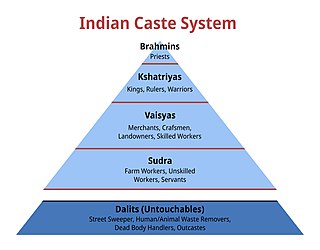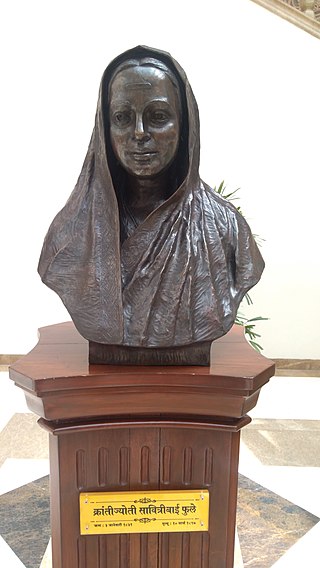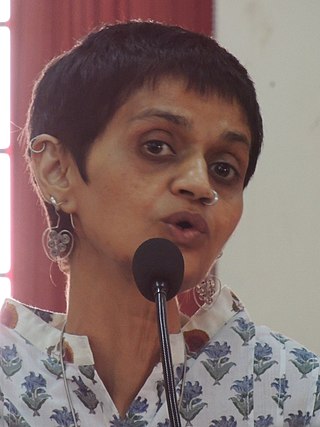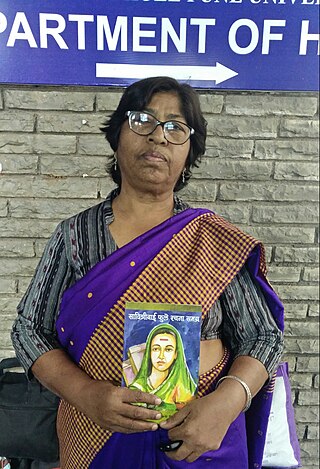
Jyotirao Phule, also known as Jyotiba Phule, was an Indian social activist, businessman, anti-caste social reformer and writer from Maharashtra.

Dalit is a term used for untouchables and outcasts, who represented the lowest stratum of the castes in the Indian subcontinent. They are also called Harijans. Dalits were excluded from the fourfold varna of the caste hierarchy and were seen as forming a fifth varna, also known by the name of Panchama. Several scholars have drawn parallels between Dalits and the Burakumin of Japan, the Baekjeong of Korea and the peasant class of the medieval European feudal system.

The History of Bihar is one of the most varied in India. Bihar consists of three distinct regions, each has its own distinct history and culture. They are Magadha, Mithila and Bhojpur.Chirand, on the northern bank of the Ganga River, in Saran district, has an archaeological record dating from the Neolithic age. Regions of Bihar—such as Magadha, Mithila and Anga—are mentioned in religious texts and epics of ancient India. Mithila is believed to be the centre of Indian power in the Later Vedic period. Mithila first gained prominence after the establishment of the ancient Videha Kingdom. The kings of the Videha were called Janakas. A daughter of one of the Janaks of Mithila, Sita, is mentioned as consort of Lord Rama in the Hindu epic Ramayana. The kingdom later became incorporated into the Vajjika League which had its capital in the city of Vaishali, which is also in Mithila.

Savitribai Phule was one of the first female teachers in India, a social reformer, and a poet. Along with her husband, Jyotiba Phule, in Maharashtra, she played a vital role in improving women's rights in India. She is considered to be the pioneer of India's feminist movement. She strived to abolish discrimination and unfair treatment of people based on caste and gender. She and her husband were pioneers of women's education in India. They started their first school for girls in 1848 in Pune at Tatyasaheb Bhide's residence or Bhidewada.
Martin Macwan is a Dalit human rights activist in Gujarat, India.

Gail Omvedt was an American-born Indian sociologist and human rights activist. She was a prolific writer and published numerous books on the anti-caste movement, Dalit politics, and women's struggles in India. Omvedt was involved in Dalit and anti-caste movements, environmental, farmers' and women's movements, especially with rural women.
Hari Narke was an Indian scholar, author, and orator. He was a professor and the head of Chair of Mahatma Jotirao Phule at the University of Pune.

Sharmila Rege was an Indian sociologist, feminist scholar and author of Writing Caste, Writing Gender. She led the Krantijyoti Savitribai Phule Women's Studies Centre, at University of Pune which position she occupied since 1991. She received the Malcolm Adiseshiah award for distinguished contribution to development studies from the Madras Institute of Development Studies (MIDS) in 2006.

Sudha Varghese, also known as Sister Sudha, is a former religious sister and social worker in India who has devoted herself to the Musahar, the Dalit of Bihar and Uttar Pradesh, one of the Scheduled Castes and who are considered the "untouchables". She resides and works in Jamsaut, a village in Patna district. She is sometimes called didi, which means "elder sister".
Bharti Dayal is an Indian artist who specializes in Madhubani art.

Krantijyoti Savitribai Phule is an Indian historical drama television series Directed by Rupesh D Gohil and Produced by RDG Productions Pvt.Ltd. The drama, aired on Doordarshan National, is based on the life of Savitribai Phule.

Fatima Sheikh was an Indian educator and social reformer, who was a colleague of the social reformers Jyotirao Phule and Savitribai Phule. She is widely considered to be India’s first Muslim woman teacher.

Rajni Tilak was one of the most prominent Indian Dalit rights activists and a leading voice of Dalit feminism and writing. She served as the Executive Director of the Centre for Alternative Dalit Media, co-founded the National Association of Dalit Organisations, and served as President of the Dalit Lekhak Sangh.
Shantabai Dhanaji Dani (1919–2001) was an Indian Dalit writer, politician, and social worker. She wrote primarily in the Marathi language.

Dulari Devi is an Indian artist and illustrator, working in the Mithila art tradition. In 2021, she was a recipient of the Padma Shri, a civilian honour granted by the Government of India, for her contributions to art.
Karpoori Devi was an Indian folk artist, painting in the Madhubani art tradition and creating textile art in the Sujni tradition. She belonged to an early generation of artists who sold Madhubani art with critical and commercial success, and her work has been archived in collections in India as well as Japan, Australia, and the United States of America.
Sita Devi (1914–2005) was an Indian artist, specializing in painting in the Madhubani tradition. She is one of the most well-known Madhubani artists from India, and was one of the first to receive national recognition for the art form, receiving a number of awards for her work including the Padma Shri in 1981, as well as the Bihar Ratna Samman in 1984. She was influential in activism for local development in her village of Jitwarpur, in the state of Bihar, and taught Madhubani art to local residents, especially women, during her career in an effort to encourage financial stability. Her paintings have been praised for their individual style, particularly their use of color, have been widely exhibited, and are archived in India as well as in museums in France, the United States, the United Kingdom, and Japan.
Shanti Devi Paswan is an Indian artist from Bihar, known for her work in the Godna style of Mithila painting. She belongs to the Dusadh caste, a community traditionally associated with this region. Shanti has adapted Godna painting, which has its origins in tattooing practices, into a notable form of Mithila art. Her work has been showcased internationally, including in the United States, Japan, Denmark, Malaysia, Germany and Hong Kong.











